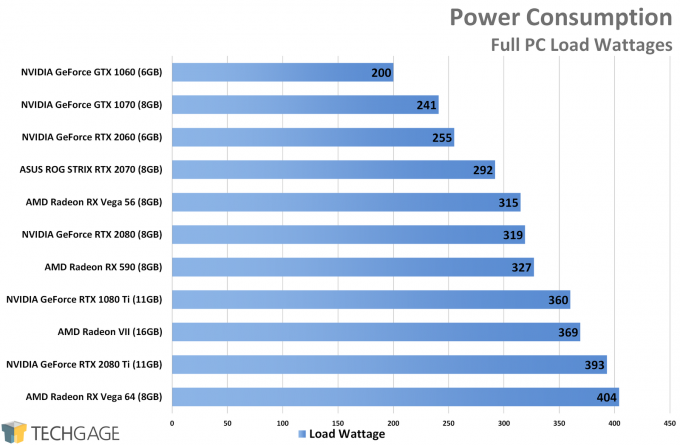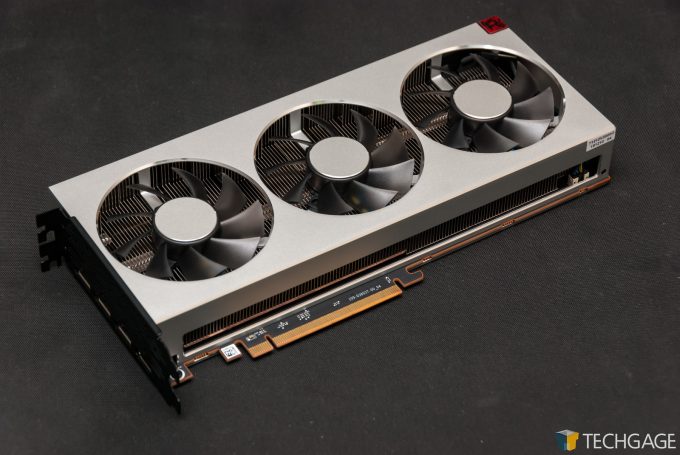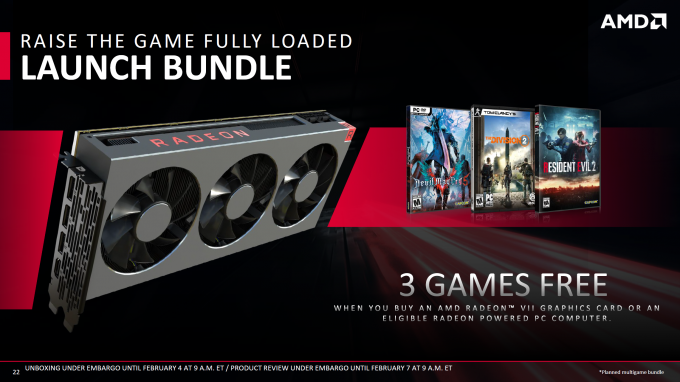- Qualcomm Launches Snapdragon 4 Gen 2 Mobile Platform
- AMD Launches Ryzen PRO 7000 Series Mobile & Desktop Platform
- Intel Launches Sleek Single-Slot Arc Pro A60 Workstation Graphics Card
- NVIDIA Announces Latest Ada Lovelace Additions: GeForce RTX 4060 Ti & RTX 4060
- Maxon Redshift With AMD Radeon GPU Rendering Support Now Available
AMD Radeon VII 1440p, 4K & Ultrawide Gaming Performance

AMD’s competition has launched four current-gen GPUs since the fall, so its fans have understandably been anxious for a follow up to 2017’s RX Vega. With the new Radeon VII, AMD is responding. It’s the “world’s first 7nm gaming” GPU, and with 16GB of VRAM, it’s one that’s built for high detail at high resolution.
Page 5 – Power Consumption & Final Thoughts
Power Consumption
To test for power consumption, a Kill-A-Watt that the PC itself is plugged into is used for monitoring a Far Cry 5 4K benchmark run. Admittedly, we don’t have the best methods for power testing, and would love to improve them in the future, but for now, we use what we have, and that’s our eyeballs. Over the course of the one-minute benchmark, a rough average is pulled.
7nm can of course mean less power draw, and in Radeon VII’s case, it manages to draw ~50W less than the Vega 64, while easily outperforming it at the same time. Of course, RX Vega’s high power draw can be remedied with Wattman, but sadly, most people won’t know to use it, so it’s nice to see VII’s power draw to be a lot more modest out-of-the-gate. It could possibly be improved further if you want to spend time in Wattman, but up to this point, time hasn’t allowed us to dig into that.
Final Thoughts
It feels weird to summarize a graphics card for gaming use when it feels so much like a workstation card, but fortunately, we have another article to dive deeper into that side of the market. To wrap things up in this article, we want focus on gaming – especially for the “World’s First 7nm gaming” GPU.
Is this world-first worth $699? That is going to largely depend on your level of enthusiasm for buying a card that offers a bit less performance than the RTX 2080, but for the same amount of money. Across our twenty-six sets of results from real games (not synthetics), NVIDIA led the pack fifteen times, sometimes to a significant degree (mostly in Monster Hunter World and F1 2018.)
If you’re indifferent to features like Microsoft’s DXR, and NVIDIA’s own technologies like DLSS, Ansel, and don’t mind slightly weaker performance, then the Radeon VII could serve you well. For gamers who are also content creators, the card looks even better. For those folks, 16GB for $700 will seem like a steal, especially when AMD’s OpenCL performance is as strong as it is (the compute article can fill you in).
When all is said and done, general performance expectations of the Radeon VII based on our testing can be seen in this table:
Game Performance Expectations |
|||||
| 1080p | 1440p | 3440×1440 | 4K | 144Hz | |
| RTX 2080 Ti | ★★★★★ | ★★★★★ | ★★★★ | ★★★★ | ★★★★ |
| RTX 2080 | ★★★★★ | ★★★★★ | ★★★★ | ★★★ | ★★★★ |
| Radeon VII | ★★★★★ | ★★★★★ | ★★★★ | ★★★ | ★★★★ |
| TITAN Xp | ★★★★★ | ★★★★★ | ★★★★ | ★★★ | ★★★★ |
| GTX 1080 Ti | ★★★★★ | ★★★★★ | ★★★★ | ★★★ | ★★★★ |
| RTX 2070 | ★★★★★ | ★★★★★ | ★★★★ | ★★★ | ★★★ |
| GTX 1080 | ★★★★★ | ★★★★ | ★★★ | ★★ | ★★★ |
| RX Vega 64 | ★★★★★ | ★★★★ | ★★★ | ★★ | ★★★ |
| GTX 1070 Ti | ★★★★ | ★★★ | ★★ | ★ | ★★ |
| RX Vega 56 | ★★★★ | ★★★ | ★★ | ★ | ★★ |
| RTX 2060 | ★★★★ | ★★★ | ★★ | ★ | ★★ |
| GTX 1070 | ★★★★ | ★★★ | ★★ | ★ | ★ |
| RX 580 | ★★★ | ★★ | ★ | ★ | ★ |
| GTX 1060 | ★★★ | ★★ | ★ | ★ | ★ |
| RX 570 | ★★★ | ★★ | ★ | ★ | ★ |
| GTX 1050 Ti | ★★ | ★ | ★ | ★ | ★ |
| RX 560 | ★★ | ★ | ★ | ★ | ★ |
| GTX 1050 | ★ | ★ | ★ | ★ | ★ |
| RX 550 | ★ | ★ | ★ | ★ | ★ |
| 144Hz values estimated for high detail 1080p 144 FPS. ★★★★★ 60 FPS? More like 100 FPS. As future-proofed as it can get. ★★★★ Surpass 60 FPS at high quality settings with ease. ★★★ Hit 60 FPS with high quality settings. ★★ Nothing too impressive; it gets the job done (60 FPS will require tweaking). ★ Not recommended. |
|||||
NVIDIA’s RTX 2080 beat out AMD’s Radeon VII in the majority of our tests, but ultimately, both cards perform about the same. It’d be hard to award an extra star somewhere to one card over another, because both trade punches, and NVIDIA doesn’t deliver so much extra performance in all of its cases to warrant a bump. Ultimately, the 2080 Ti should be your choice if you want the best possible 4K experience. Otherwise, both the Radeon VII and 2080 offer very good performance.
Unfortunately, my experience with Radeon VII was marred with issues in two of the eight games tested, especially with Wildlands, which simply refused to complete a benchmark run without crashing (and again, even sitting at the main menu will encourage a spontaneous crash at some point).
In talking to site friends who also have the VII in for testing, I can say that no one was able to report similar crashes to me, although none of them test with either of the two games that bugged out on us (the second one being Forza Horizon 4). I do expect these issues to be fixed, but would have loved to have not seen them in 25% of the games I tested with. Fortunately, I didn’t encounter any real issues when testing the VII for workstation performance (again, head here if you want to read that).
If there’s another caveat with VII to be aware of, it’s that its fan noise is loud in comparison to NVIDIA’s cards. In testing the six GPUs for gaming here, only the Vega 64 and VII stood out to me on the noise-front. I watched a fair bit of TV while running all of this benchmarking, and with the VII (and V64), I had to crank the volume on the TV in order to hear it, whereas when the NVIDIA cards were testing, I didn’t even think of it. It doesn’t take a hardcore workload to hear the card, either. Merely sitting at a game’s main menu would cause it to happen to us.
As mentioned in the power section above, AMD’s tools can help you refine things to make the situation better, but we didn’t have time to dig in before embargo. For headphones users, this noise might not matter much, but if you use speakers, you are going to easily hear the VII above any other recent card, at least without tweaking.
We didn’t want to finish up this look without a mention of AMD’s ongoing game bundle, which applies just fine to the new Radeon VII. Purchased separately, these games would cost you about $180, so if you’re keen on them, that is a substantial savings. Even if you were planning to purchase only one of these games, that’s still money saved. And, if you didn’t want any of them, you’re probably more concerned about your creative work that needs tackling!
By now, you should know whether or not a Radeon VII is for you, and if you deem that one is, then hopefully you will be able to find one in stock soon. Pre-launch rumors claimed that availability would be pretty rough at launch, but we have quite literally no knowledge on the actuality of card supply. All we can do is hope there’s enough for those who want it, if not now, then soon.
Support our efforts! With ad revenue at an all-time low for written websites, we're relying more than ever on reader support to help us continue putting so much effort into this type of content. You can support us by becoming a Patron, or by using our Amazon shopping affiliate links listed through our articles. Thanks for your support!








